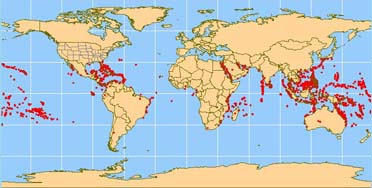I saw a book today about reefs. I opened the book and there were spectacular photos of super-bright fish, crazy-shaped coral, and all kinds of spiny things. I've gone snorkeling a couple of times at some reefs in the Caribbean, and I think the whole thing is fascinating. You stick your head an inch underwater, and it's like you're suddenly Jacques Cousteau, in the middle of fantasyland.

Photo by Mary L. Frost
- A reef is made up of many coral polyps. A polyp is a tubular, saclike animal with a mouth surrounded by tentacles. It's hard to believe these things are animals, but they are. Like the fish that live among the reefs, the polyps can be many very bright colors.
- The tentacles are generally how the polyp gets food to its mouth. The tentacles may be short or long, or they may have venom-filled stingers on them called nematocysts which attack the prey and bring it to the coral's mouth.
- Polyps eat zooplankton, or very small fishes. Usually, they eat at night.
- Polyps also get much of their nutrition from coral algae. Also called zooxanthellae, the algae live on the coral and provide nutrition to it. The zooxanthellae need sunlight for photosynthesis, and this is why most coral only live in shallow water.
- Sometimes the coral will "bleach" or expel the coral algae, and when this happens, the coral have very little energy and will not reproduce, and they also lose their color. Coral are very sensitive to all kinds of environmental stressors such as pollution, changes in water temperature, UV radiation, and changes in the amount of salt in the water. Any of these stressors may trigger bleaching.
- As the polyps grow, they secrete skeletons made of calcium carbonate, something like bone. Other animals living around them bore into the skeletons and grind them up, making sediment. The sediment settles into the spaces around the polyps, and the algae and other minerals mix with the sediment and turn it into something like cement, which stabilizes the colony of coral.
- Almost all reef-building coral are what is called sessile animals, meaning they spend their entire adult lives rooted to a single spot on the sea floor.
- Coral polyps reproduce in lots of different ways, depending on the species. Some polyps are hermaphroditic, meaning they can fertilize themselves. Some are asexual, and "bud" offspring by pinching off parts of itself to plant it elsewhere nearby.
- My favorite method of coral reproduction, though, is called synchronous spawning. This is when all the polyps release a massive cloud of eggs and sperm into the water at the same time. Exactly when this happens depends on lunar cycles and tidal levels and water temperature and other factors, but still, somehow they all know when it's time to let 'em rip. The sloshing water mixes the eggs and sprem together and over a period of about four to ten days, the eggs get fertilized to form larvae, which settle to the sea floor and form polyps.
- There are approximately 6,000 species of reef-building corals. They provide shelter and food for all sorts of animals, including sponges, fungi,sea worms, sea urchins, jellyfish, oysters, clams, shrimp, crabs, turtles, parrot fish, clown fish, and hundreds of other kinds of fish.

Where you can find the major coral reefs in the world (Diagram from NOAA)
If you want to learn more about a specific type of coral, take a look at my entry on Sea Fans.
Sources
Seaworld Education Department's pages on Corals and Coral Reefs
University of the Virgin Islands Coral Reef Ecology page
Mary L. Frost's photo appeared in Brian Huse, "Communities Around the Globe Protect the Underwater World," Shared Oceans, Shared Future, April 2004
Diagram appeared in NOAA's What are Corals and Coral Reefs? article, which is part of its highly informative Coral Reef Information System.
Thankyou so much for posting this, I did a report on Coral Reefs for my Biology class, and this really helped me.
ReplyDeleteYou're welcome, Anonymous! This entry is one of my favorites, since I find coral reefs so colorful and fascinating.
ReplyDeleteI hope your instructor likes your paper!
--the Apple Lady